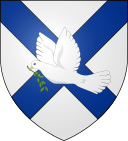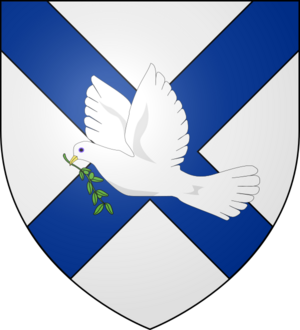Knox College, Otago facts for kids
Quick facts for kids Knox College |
||||||||||||
|---|---|---|---|---|---|---|---|---|---|---|---|---|
| University of Otago Residential College | ||||||||||||

Knox facade
|
||||||||||||

Knox College coat of arms
|
||||||||||||
|
|
||||||||||||
| University | University of Otago | |||||||||||
| Location | 9 Arden St, North East Valley, Dunedin | |||||||||||
| Motto | Gratia et Veritas (Latin) | |||||||||||
| Motto in English | Grace and Truth | |||||||||||
| Founders | Rev Andrew Cameron and John Ross | |||||||||||
| Established | 1909 | |||||||||||
| Status | Affiliated | |||||||||||
| Head | Caroline Hepburn-Doole | |||||||||||
| KCSC President | Hadley van Rij | |||||||||||
| Undergraduates | ~255 | |||||||||||
| Postgraduates | ~5 | |||||||||||
Knox College is a special place where students live while studying at the University of Otago in Dunedin, New Zealand. It was started by the Presbyterian Church of Aotearoa New Zealand. The college is located on a large, beautiful piece of land in Opoho, right across from the Dunedin Botanic Gardens.
Knox College is one of the oldest student homes in New Zealand, founded in 1909. It was designed to be like the famous colleges at Oxbridge universities in England. Over the years, Knox has kept its unique college feel while also changing to be a welcoming place for all students. Since 1983, both male and female students have lived there. Many students from Knox College have won important scholarships, like the Rhodes Scholarship and Gates Scholarship.
Contents
History of Knox College
Knox College first opened in 1909. It was built to provide a home for male students and to house a training school for Presbyterian ministers. In 1983, it became a place for both male and female students to live.
The college is named after John Knox, an important leader from Scotland in the 1500s. He believed in free education for everyone, focusing on both learning and building good character. His ideas greatly influenced education, not just in Scotland, but around the world. Many Scottish settlers, who came to New Zealand, brought these ideas with them.
Learning and Support
Knox College helps its students succeed in their studies. They offer extra classes called tutorials and check on how students are doing. The college also has its own library, the Hewitson Library. Students can study there and use its many books and journals, some of which are very old and important. Many students from Knox College have won the prestigious Rhodes Scholarship.
When students join Knox College, they become part of the Junior Common Room (JCR). There's also a Senior Common Room (SCR) for postgraduate students, professors, and other important people. The Ross Fellowship, started in 1920, is the oldest award of its kind at the university.
Knox College Students' Club
The Knox College Students' Club (KCSC) used to be the oldest student club of its kind in New Zealand. It organized many fun events for students, like the annual Ball held at Larnach Castle and the Concert on the Stairwell. They also arranged sports and cultural competitions against Selwyn College, called the Cameron Shield and Nevill Cup.
The KCSC used to have an executive committee with student leaders. Now, a team of student leaders works with college staff to plan these activities. Some former presidents of the Students' Club later became leaders of Knox College.
Knox College is special because it's privately owned. This means students can often stay for a second or even third year. Students who return help new students feel welcome and pass on college traditions. In recent years, about 40% of students have been male and 60% female, which is similar to the university's overall student numbers.
Celebrating 100 Years
In 2009, Knox College celebrated its 100th birthday! About 600 guests came to different events over a weekend in August. The oldest former resident, who lived there from 1938 to 1943, planted a special Centennial Oak tree to remember the occasion.
Knox College and Other Colleges
Knox College shares its land with Salmond College. Even though they operate mostly on their own, they are managed by the same group, the Board of Knox College and Salmond College. They also share some staff members, like a General Manager and a Food Services Manager.
Knox College also has a friendly rivalry with Selwyn College. They compete every year for the Nevill Cup (cultural events) and the Cameron Shield (sporting events).
College Buildings
The buildings at Knox College are very impressive. They show how an architectural idea was carefully built over many years.
Early Construction
The Presbyterian Church started a training school for ministers in Dunedin in 1876. In the early 1900s, they bought land in Opoho to build a new home for the school and for students attending the University of Otago. In 1906, a young architect named William Gray Young won a competition to design the college.
Young's plan was for four buildings around a central courtyard. The first part built was the main tower and the northern parts of the west building, along with the North Wing. This section included teaching rooms, a dining hall, and staff accommodation.
Construction began in 1908, and the building opened in 1909. It cost £19,307. The buildings were made of brick with special stone details and red tile roofs. The style was called Jacobethan, which is a type of Gothic revival architecture. It features classic elements like arched doorways and battlements.
Growing the College
The second stage of building included the southern part of the west building and the chapel. This part was finished in 1914. The college buildings are very visible from far away because they are on a high site. The college leaders even asked the architect to make the tower taller, from four to five stories!
The inside of the buildings had large rooms with beautiful details, like wooden panels in the Dining Hall and stained glass in the chapel. Even so, the college was still not complete as Young had imagined it.
Plans to add to the South Wing were ready by 1929, but big events like the Great Depression and World War II stopped the work.
After the Wars
By 1945, the college needed more space for both the training school and the student residents. William Gray Young was getting older, so Arthur Salmond took over the project. A new building, called the Hewitson Wing, was opened in 1955. It was built behind the main west building, completing the east side of the courtyard. This new building included a library and a hall.
The Hewitson Wing used modern building methods like reinforced concrete but still matched the look of the older buildings. The library inside was designed to look like an old Elizabethan room.
Because there were more students, the Dining Hall became too small. So, in 1957, it was extended. The extension added a special bay window with stained glass and created space for the main table.
In 1959, the college started working on the South Wing again. The building, named the Ross Wing, was opened in 1963. It also used reinforced concrete but was styled to match the existing buildings. This further closed off the courtyard.
The courtyard was almost finished. In 1984, the library was extended. This addition completed the east side of the courtyard, leaving only a small open space.
Recent Updates
In 2008, the Hewitson Building was updated to create offices and teaching spaces for the Knox Centre for Ministry and Leadership. It also provided a special home for the Presbyterian Archives.
Between 2012 and 2013, the main residential building was made stronger to be safe in earthquakes. At the same time, 40 new rooms were added for students. The main building was also renovated from top to bottom. The Great Hall was opened up to the Junior Common Room to make more space for formal dinners. More renovations happened in 2019-2020 in an area known as Somerville Close.
Presbyterian Research Centre
Knox College is home to the Presbyterian Research Centre, located in the Hewitson Library. This center was created in 2013 by combining the Hewitson Library and the Presbyterian Archive. Its job is to keep and protect the history and records of the Presbyterian Church of Aotearoa New Zealand.
The center holds many important collections. These include records from the church's main assembly, youth and women's groups, local churches, and personal papers of important church leaders. Two of their collections are so important that they are listed on the UNESCO Memory of the World Aotearoa New Zealand Ngā Mahara o te Ao register.
- The Ng New Zealand Chinese Heritage Collection was added in 2017. It contains materials collected by historian James Ng about the early history of Chinese communities in New Zealand.
- The PCANZ Deaconess Collection was added in 2018. It tells the story of 175 Presbyterian women who became deaconesses between 1901 and 1975. This was a time when women were not allowed to be ordained as ministers in the church.
Changes in Leadership
In 2012, some changes were made to how Knox and Salmond Colleges were managed. A special group was put in charge to help improve the college's culture and student well-being. This led to many positive changes.
In 2015, a new Board of Knox College and Salmond College was created. By then, the church was happy that the changes had been made and the college culture was improving. In 2017, the board shared its goal for Knox College: "To be a world-class residential college where students are part of a community that affirms and empowers every resident, expands thought and outlook, encourages service, fosters leadership, and builds strong bonds of friendship."
In 2021, Caroline Hepburn-Doole became the first female head of Knox College. She had been the college's deputy master for five years before that.
Famous Former Students
|
Many of these people lived at the college. Some who studied Divinity might have received lessons while living elsewhere.
College Coat of Arms
The coat of arms for Knox College shows its strong Scottish Presbyterian roots. It features a blue St Andrew's Cross. On top of the cross is a white dove flying, holding an olive branch. This image comes from the Bible story of the flood in Genesis, where the dove with an olive branch symbolizes new life and peace.
The college motto is Gratia et Veritas. This is Latin for "Grace and Truth," and it comes from the Gospel of Saint John in the Bible.
 |
|
Images for kids
-
Elevation of a wapiti in the modern-day Great Hall









